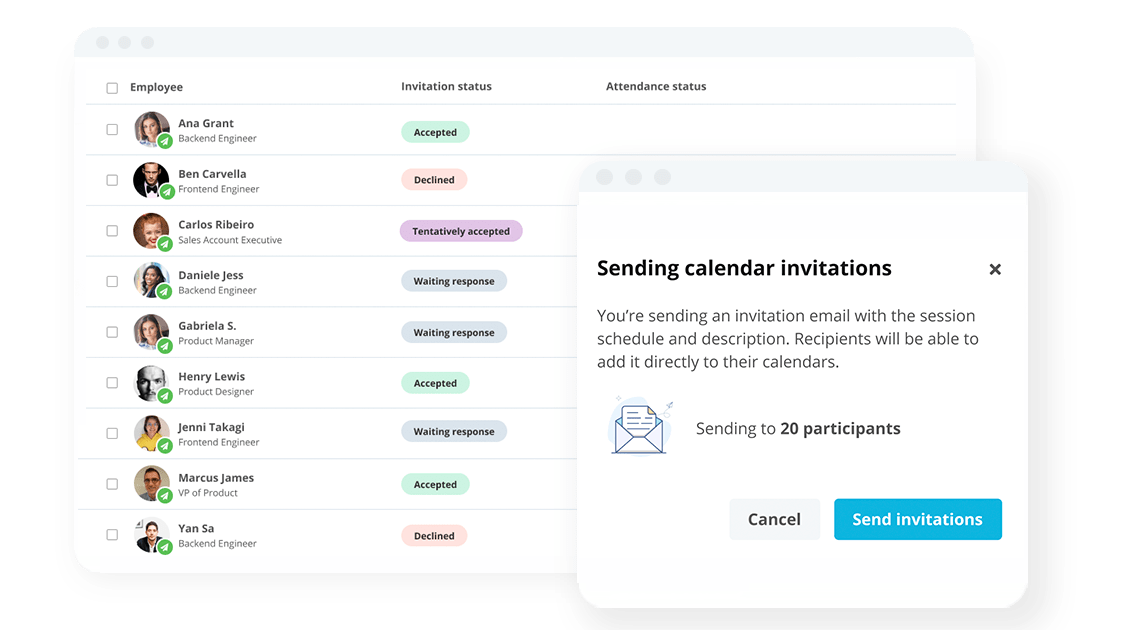
Give the Right Training at the Right Time
Simplify your staff development with centralised training management.
Future-proof Teams With PersonioIs the ADDIE Model Truly Useful?

There’s a reason why the ADDIE model is the most popular training framework out there. Using it, you can develop a new course with ease. Here’s our guide to the five phases of the ADDIE model and why you might consider using it to design your next great learning experience.
What Is the ADDIE Model?
The ADDIE model is an instructional design model used by training developers and other educators. It consists of five critical phases: Analyse, Design, Develop, Implement and Evaluate.
Since its development in the 1970s, experts have used the ADDIE Instructional Design (ID) model to plan and design training programs. Even after five decades, ADDIE is still the most commonly used ID model.
Although the model is listed sequentially, it’s evolved to be more flexible, allowing for continual improvement and iteration.
The ADDIE Process
While originally designed to be completed in a linear fashion, the ADDIE process we know today is more dynamic and interactive:
Phase 1: Analysis
Before developing any new instructional content, it’s important to analyse the current situation. Take a look at how everything is organised and designed to gain a better understanding of the gaps you need to fill. The Analysis phase is also where you’ll set your instructional goals and objectives.
Ask good questions – using who, what, why, where, when and how – such as:
Who is the audience?
What are their core characteristics?
What problem are we aiming to solve?
What is the outcome we hope to achieve?
Why might the audience want to do this training?
What is the current knowledge level of the audience? Are there any gaps?
What tools do we need to deliver the information?
Where will this training take place (i.e. e-learning or in-person)?
When does this project need to be completed?
Milestone: At the end of the Analysis phase, you should have a plan for your course or training and know what you will need to achieve the desired outcome.
Phase 2: Design
In the Design phase, we use everything we compiled in the analysis phase to start designing the optimal learning experience. This phase of the ADDIE model often takes the longest and requires the designer to have great attention to detail.
This is when you will work on designing key attributes such as:
Learning objectives
Subject matter & content
Lesson planning
Exercises & assessments
Media (e.g., videos, images, graphics, audio, etc.)
Duration
Feedback
Next is to create a storyboard, or, if time permits, a working prototype to communicate the training’s value to other stakeholders.
Milestone: At the end of the Design phase, you should have an outline for the course, design elements and a storyboard and/or prototype.
Phase 3: Development
During the Development phase, it’s time to bring your ideas and plan to life by actually building the learning experience. By this point, the content and strategy has been decided. If the design phase was done properly, you should be able to use your storyboards and/or prototype to guide you.
Some of the activities of the Development phase include creating graphics, recording audio and videos and (where applicable) working with programmers to develop or integrate necessary technologies.
Development is not only for creating learning outcomes but for testing them, too. This phase of the ADDIE model should be highly iterative (i.e. built by rounds of feedback).
Milestone: At the end of the Development phase, your entire course or training should be completed.
Phase 4: Implementation
Your course has been created – now it’s time for learners to try it out!
If you are creating an online course (i.e., eLearning), you will typically need to upload your course to the Learning Management System, or LMS. Delivery aspects will need to be dictated as well, such as:
Who will be enrolled
How much time they will be given
What the passing threshold will be for assessments
How feedback will be collected
This phase is iterative as well, and instructional designers will need to continually revise, update or even redesign elements of the training as necessary.
Milestone: At the end of the Implementation phase, your course should be live in the LMS and available for learners to complete.
Phase 5: Evaluation
Now that your course or training has been designed, developed and implemented, you need to check whether the learning experience is meeting the objectives you set.
There are two parts to the evaluation phase:
Formative – Present throughout every stage of the ADDIE model
Summative – Take place at the end of the program
In other words, some form of evaluation is always taking place throughout the process. As the course is evaluated, the instructional designer needs to decide whether any issues that arose have been addressed and whether the objectives are being met.
Milestone: At the end of the Evaluation phase, you should have a better understanding of what needs to be changed or improved within the learning experience. This information should also help you better design future courses and training programs.
Streamline your employee development

Define performance cycles, set goals, give effective feedback and evaluate performance fairly. Put structure on how you grow and retain staff with powerful performance management.
Boost your performancePutting the ADDIE Model Into Practice
Applying the ADDIE model will require some planning and templating if time permits. Creating worksheets for each of the steps as well as feedback forms for learners and IDs to share their insights can be helpful.
One key tool needed for implementing the ADDIE model is your authoring tool or Learning Management System. While the ADDIE model shouldn’t necessarily be tied to any single tool, it works best with tools that support slide-based learning experiences, since they align most closely with the ADDIE format.
ADDIE Model: Advantages and Disadvantages
The ADDIE model has its advantages and disadvantages. While you’re deciding whether ADDIE is the right model to use for your instructional design initiatives, think through the pros and cons listed below…
Advantages
Advantages of the ADDIE model include:
Good starting point – ADDIE can be a great model for kicking things off in your instructional design, while also combining well with other ID models if you choose to do so.
Well-structured – ADDIE has a linear design but is typically used as a cycle (i.e. repeated and iterated). This structured guidance can help keep ID teams on track.
Flexibility & versatility – Although ADDIE is structured, it’s also quite flexible, enabling teams to revisit and revise throughout the process. It’s also versatile, in that it can be applied to every type of learning you can think of.
Disadvantages
Disadvantages of the ADDIE model include:
Time-consuming – In many cases, teams need to move quickly when creating a new course or training. The ADDIE model is quite comprehensive, but that also means it takes a long time to work through.
Linear – As mentioned before, ADDIE’s original design was to be linear. While it can turn into a cycle by repeating steps and restarting the process, the entire model can be negatively impacted if one phase has issues.
Presumptive – The ADDIE model presumes that the instructional designers already have an understanding of the learner’s requirements, which is not always the case.
Frequently Asked Questions About the ADDIE Model
What is The ADDIE Training Model?
The ADDIE model is a framework used for Instructional Systems Design (ISD) designed in the 1970s. It consists of five phases – Analyse, Design, Develop, Implement and Evaluate – and is the most commonly used model for instructional design.
What Are the 5 Phases of the ADDIE Model?
The 5 phases of the ADDIE training model are Analyse, Design, Develop, Implement and Evaluate.
Where Is the ADDIE Model Used?
The ADDIE model is used in training and development teams and by instructional designers in all fields to develop educational programs, whether online or in print. ADDIE is used heavily in the design of corporate eLearning and training programs.
What Is the Most Important Phase in the ADDIE Model?
While every step in the ADDIE model is crucial to designing effective learning experiences, many instructional designers see the first step, Analysis, as the most important. Creating a solid foundation for the rest of the model, this initial Analysis step is the critical stage in many processes, not just ADDIE.
Make the Most of Your Training With Personio
No matter how perfectly you design your course or training with the ADDIE model (or any other framework), it’s only effective if people actually complete it.
With Personio’s training management software, you can track training attendance, progress and compliance across your organisation from one central, easy-to-use tool. This way you can ensure your employees get the development opportunities they need to upskill, grow in their role and help your business prepare for the future.